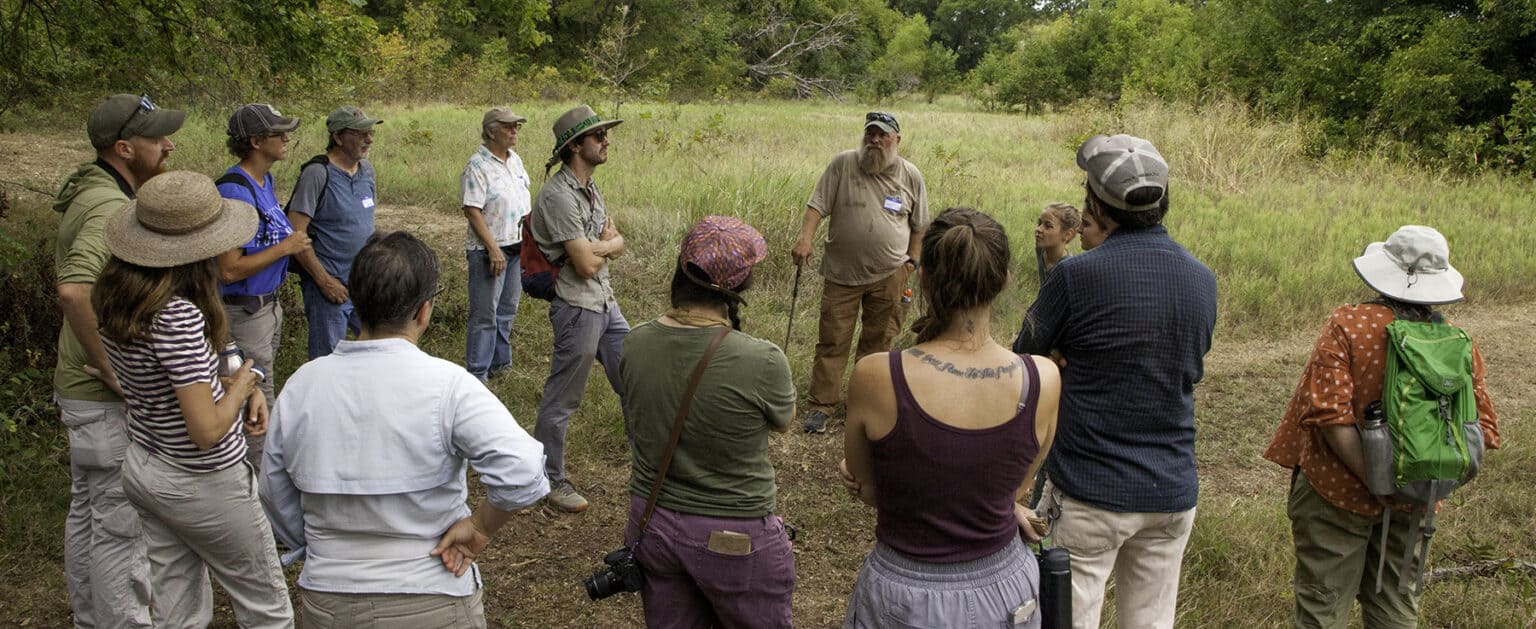Registered Natural Areas serve as classrooms, storehouses for healthiest habitatsBy KELLY BOSTIAN For the CCOF Copperhead Ridge Registered Natural Area had a little something for everyone who visited recently, except copperheads, the snakes were shy during the first Oklahoma Natural Areas Field Day since COVID stalled the program two years ago. Brandon Gibson’s broad-brimmed hat tilted above the tallgrass prairie like a sunflower chasing rays as he spent hours, head lowered, on one small hillside collecting seeds of prairie grasses and wildflowers. Kim Bishop barely left the hilltop parking area before she waved her long white net to catch a monarch butterfly. Some of the group of about 30 people gathered ‘round to learn how she handled and tagged the butterfly, now on its southern migration to Mexico. “This is a good day. We had a landowner show his property and he got everyone enthusiastic about good land management and managing for biodiversity,” said Pricilla Crawford, conservation biologist for the Oklahoma Biological Survey. “We had a lot of networking going on and plans being made for the future. The purpose of this is really to show what can happen with good land management and that it’s not impossible to manage for biodiversity.” Areas for preserving, learning
a network of experts and fellow landowners ready to provide advice, including site visits. “We currently have 120 landowners representing 90 sites statewide, all volunteer conservators of their property,” Crawford said. Field days, usually limited to groups of 50 or less, allow landowners to network and learn from one another, but anyone is welcome to attend and learn in these private areas not normally open to the public, she said. Field days, usually limited to groups of 50 or less, allow landowners to network and learn from one another, but anyone is welcome to attend and learn in these private areas not normally open to the public, she said. Larry Andrews’ 162-acre Copperhead Ridge near Ponca City features tallgrass prairie hills and ridges with cross timbers loaded with chinkapin and blackjack oaks. He took over the ownership of the grazed family property about 25 years ago. The former fireman’s best tool has been his former nemesis. “I haven’t planted anything, I haven’t put down any seeds,” he said. “Most of what we’re walking on, all the trails here, are fire breaks. Everything that is here was here already as seed, I guess, waiting on fire to go again.” It wasn’t all making fire breaks and lighting matches, however. Invasive species like the woody sericea lespedeza and overly enthusiastic honey locust trees and sumac require a continual, watchful, eye. Occasional trips on the tractor to spot-spray during summer months. Fire brings changes Twenty-five years ago the prairie area of the property looked like most that are used primarily for grazing cattle for decades. “It was mostly grass, a bunch of bluestem,” he said. He now burns parcels of the property on a rotation. When he first started, he burned the entire 162 acres every other year. The annual rotation allows burns about every 3 years on individual parcels and provides more variety for the dozen or so cattle and for the wildlife, he said. “Now there is a lot more diversity,” he said. “In the spring there are tons of Echinacea (a purple coneflower) out here. And it has all these forbs and other flowers. We have goldenrod now, that was never here before.” Andrews also has feral pig traps on the property, one large hog, in particular, required some ingenuity to alter the traps to make them escape-free “Those pigs can be incredibly destructive,” he said. In addition to his participation with the Registry, Andrews enrolled his property with the Natural Resource Conservation Service, which allows him to take advantage of some financial incentives and helps him with planning. Duel Brown, the NRCS rangeland management specialist who works with Andrews said he visits the property a couple of times a year or helps manage a burn. This year marks the end of a 5-year plan, so over the course of a few weeks, soon, he will assess the property with Andrews and develop a strategy for the next five. The work involved is ongoing, like anything in farming or ranching, he said. Two of the things people need to know are that managing with both economics and ecology in mind can be profitable and that results are not always immediate, he said. As an example, as pristine as the Andrews property appears, it now has some woody sumac that is spreading into the prairie, he said.
“That’s something we might look at with some prescribed grazing with goats, to control that woody encroachment,” Brown said. “His wife is getting into raising goats and with grazing they might want to run a few more goats and that can be an economic driver.” Kelly Bostian is an independent journalist writing for The Conservation Coalition of Oklahoma Foundation, a 501c3 non-profit dedicated to education and outreach on conservation issues facing Oklahomans. Learn more at oklahomaconservation.org.
0 Comments
Leave a Reply. |
Archives
May 2024
Categories
All
|
Conservation Coalition of Oklahoma
P.O. Box 2751
Oklahoma City, OK 73101
[email protected]






